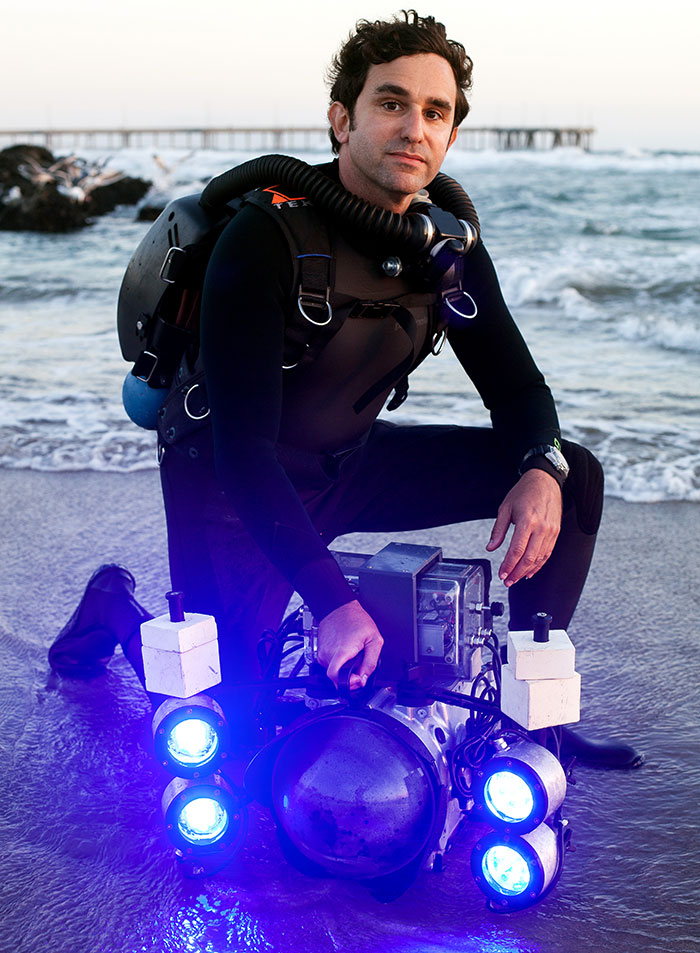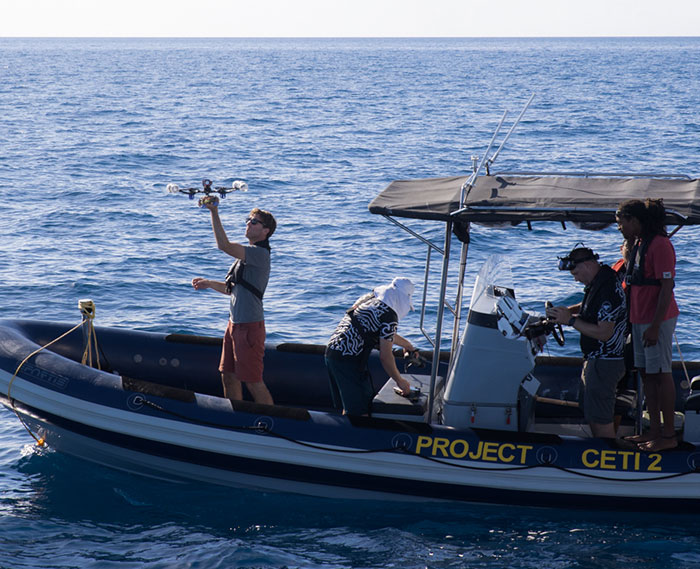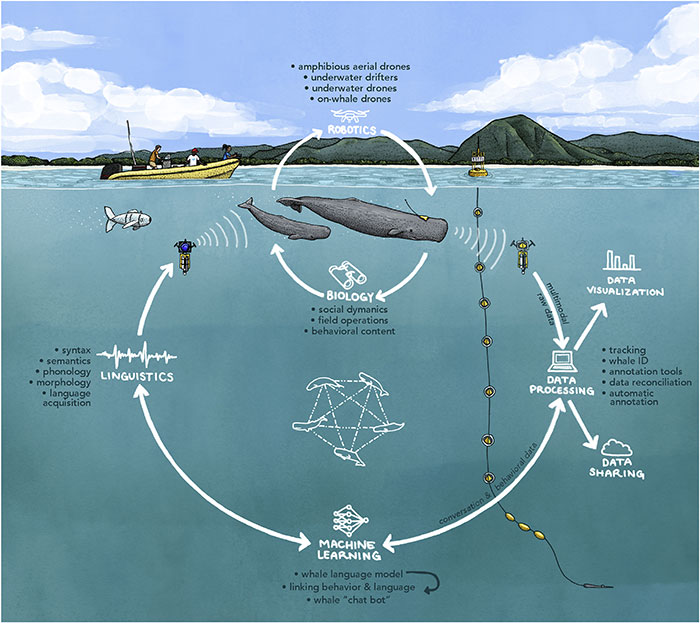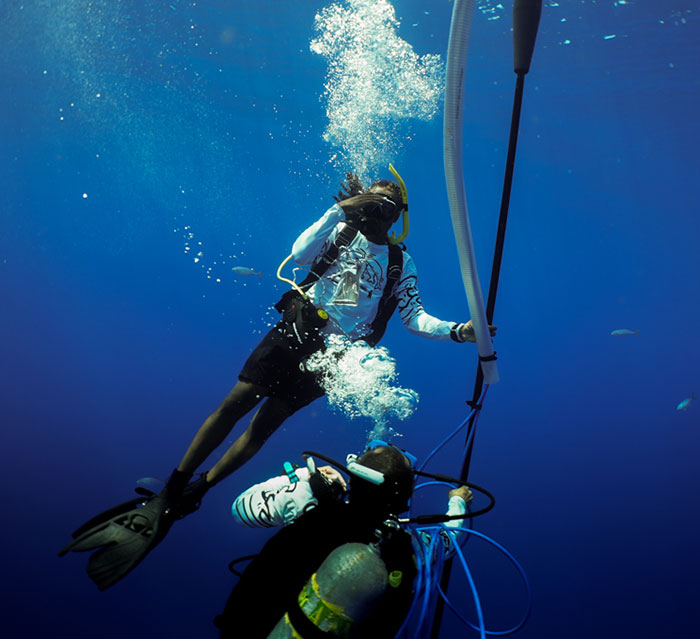The possibility of talking to animals one day is not as far off as it may seem. A group of scientists located in the Eastern Caribbean country of Dominica is actively working to translate the intricate language of whales into a form of communication that humans can understand.
They are part of Project CETI, a nonprofit organization utilizing artificial intelligence (AI) to decode the complex calls and sounds of sperm whales with a mission to “transform human understanding & connectivity.”

Image credits: Amanda Cotton
In an exclusive interview with Bored Panda, CETI’s president and founder, David Gruber, dove deeper into the astounding capabilities of AI and how his research could one day allow us to talk to extraterrestrials.
Scientists are using AI to decipher whale language, which may one day lead to the possibility of otherworldly communication

Image credits: Amanda Cotton
A whopping 99% of the AI that’s been created is solely geared toward humans and our need for additional knowledge about ourselves. From hospital records to libraries, we already have a “tremendous amount of information” about our species.
However, in March of 2020, the idea of using AI for something “non-human” was born and in came Project CETI—an organization driven by the hypothetical question: “What would happen if we could understand what other animals are saying?”
David Gruber told Bored Panda they’re focusing on slowly translating the “click-based communication system” of sperm whales—scientifically known as “codas”—into something similar to our language.

Image credits: Elias Carlson
“[We’re] learning one phrase at a time as we imagine we’re like baby whales, and we’re learning the communication system of the whales, from the ground up,” he said.
The goal is to “peer into the whale’s world” by using AI to collect the animals’ audio and later have the computer recognize “the voices of each individual whale.”

Image credits: Project CETI
Earlier this year, Project CETI’s team released a paper illustrating what the sperm whale phonetic alphabet might look like. The scientists have plans to publish another article showing that the features in the whale’s communication system mirror that of vowels.
Upon a deeper look, sperm whales share a handful of similarities with humans, making them the perfect test subjects

Image credits: Alex Boersma
Lead biologist of the team, Shane Gero, had been studying these animals in Dominica for 15 years and had built up an “amazing” database of 10,000 subjects.
With all the knowledge he’s gathered, scientists were able to discover that sperm whales from different areas have regional accents in their codas—which is perfect for computers to work with.
“A click is almost like a one and a zero for cryptography or decoding,” David explained.

Image credits: Amanda Cotton
Additionally, sperm whales live in organized social communities and are “very long-lived animals,” with a typical lifespan of 70 years, meaning “there’s a lot of time for information to be passed among these generations.”
An important piece of information David pointed to involved the brain of a sperm whale, which weighs approximately 18 pounds, making it the largest brain of any animal in the universe—that we know of.
Like humans, they also share spindle-shaped brain cells and can even feel emotions such as empathy or love.

Image credits: Project CETI
And though sperm whales have frequently been portrayed as “these leviathans and these villains” in fictional narratives, such as Moby Dick, David said it was an important personal mission of his to show them in a different light.
“Now that I’ve had a chance to work with them, they’re just the most gentle, kindest, amazing creatures,” he said.
“I’m just so honored to ever get to spend time with them.”
The prospect of talking to animals is something straight out of a fictional novel—but everyday, AI is reaching new and impossible heights

Image credits: Michael Lees, National Geographic
While scientists are looking to accomplish things that require more advanced artificial intelligence, a machine learning engineer at a Vancouver-based autonomous driving startup shed more light on AI’s current capabilities.
Already, these computer systems have become a staple in our day-to-day routine.
“AI is behind most of tech-based intelligent behavior over the last two decades,” Frederic said. “In Google translate, a paragraph in any language can be translated pretty well into any other; in Youtube, watch history prompts similar content and channel recommendations.”

Image credits: Project CETI
He added, “Perhaps unknowingly to most, AI is already widely affecting key aspects of our lives and even our future.”
Experts have already applied this technology to tasks such as reading medical journals and papers at a faster pace to inform testing sites, and looking at past court rulings and legal proceedings to generate letters that could increase their chance of winning, among others.
“AI has become the indispensable paradigm,” Frederic said.
David’s research could potentially open doors for milestones we previously thought impossible, such as conversing with aliens, especially given the potential of AI

Image credits: Project CETI
With the information gathered from the sperm whales, there is a chance we may be able to communicate with extraterrestrials if— or when—we make contact.
If the unimaginable becomes a reality one day, and humans make contact with “non DNA-based” intelligent life, the National Geographic scientist believes the research he’s done with sperm whales would be “laying the groundwork” for a new form of conversation.
“These tools could be applied in the distant future,” he said, adding, “If we can’t translate here on Earth, I think it’s gonna be really, really hard to do this kind of work on another planet.”

Image credits: Project CETI
While scientists have yet to prove life exists beyond Earth, David said, “There’s definitely this possibility that there’s some other life out there.”
According to Mario Livio, an astrophysicist at the Space Telescope Science Institute in Baltimore, Maryland, the number of galaxies in the observable universe are almost beyond human comprehension—ranging from a shocking 100 to 200 billion.
Within these galaxies are countless stars and planets that are capable of fostering life.

Image credits: Project CETI
— Sefton Hanley (@seftonhanley) February 22, 2024
NASA reported that water, elements associated with life, and available sources of energy have been present in almost every place astronauts have looked.
The end goal has always stayed the same: discover whether life exists outside the planet and further our understanding of the universe. But until that day comes, David is determined to continue learning more about “inter-terrestrial life” before looking beyond our world.
Commenters were excited to see what this project could mean for the future of science

Image credits: bridget2034

Image credits: JustinDMcCarty

Image credits: WilliamLamkin

Image credits: Bsunter

Image credits: thetechbrother

Image credits: DigibitArt

Image credits: best_is_west

Image credits: BigBuski

Image credits: jc_y42
The post AI Is Translating Whale Language, Which May Help Us Communicate With Aliens One Day (Exclusive) first appeared on Bored Panda.
from Bored Panda https://ift.tt/nfwdIg5
via IFTTT source site : boredpanda